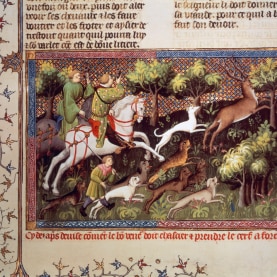Hunting techniques
Hunting techniques vary according to the game and its habitat. They are governed by strict rules on the equipment used and the behaviour to adopt. The use of traps, for example, has been prohibited as it infringes on the dignity of the animal. Hunting from a hide and stalking are both practised individually and rely on good observation and knowledge of game. Beating is a group activity, often with the help of dogs who flush out the prey towards the marksmen.
Flint, bow, falcon, gun: a brief history of weapons
The first peoples had a nomadic way of life and moved around to find game which provided them with food, fur to protect themselves against the elements, and materials (bones, hooves, horns) to make tools. The first carved stone tools were used to kill as well as to cut. After the domestication of fire some 400 000 years ago, hunter-gatherers honed their skills to turn raw materials such as flint into hunting weapons. They made use of the terrain (chasms, marshes) to capture and kill their prey, then created traps, often by digging trenches, to hunt more efficiently. Weapons became more refined and complex over time. The use of bows and arrows spread all around the world, except in Australia where the boomerang was the weapon of choice.
Other hunting techniques, such as beating, involve collaboration between humans and animals. It is thought that dogs have been tamed for this purpose since Neolithic times, and horses since the 2nd millennium BCE. The Assyrians already mastered the art of falconry 2700 years ago, a practice that was also known in China and India at that time. Several treatises on hunting techniques were written during Antiquity, including Kynegetikos (On Hunting) by the philosopher Xenophon in the 4th century BCE. This treatise mentions hunting hare, boar and deer.
In the Middle Ages, horses, falcons and dogs were still an essential hunting aide, as were bladed weapons and throwing weapons (bows, spears for boars, swords and knives). In general, weapons used in combat were also used for hunting. The first recorded use of firearms (arquebuses) dates back to the 16th century. Nowadays, in developed countries where hunting is mostly a leisure activity, guns and rifles have become the most commonly used weapons.
Hunting from a hide, stalking, beating, snares: a typology of techniques
Hunting entails pursuing and killing furred or feathered animals, as well as some aquatic mammals such as whales. The techniques vary according to the game and its habitat, and hunting is practised alone or in a group.
Hunting from a hide and stalking are done individually and are described as ‘silent’, as they rely on being able to watch the animal without it noticing. The former method is static and is done from a hide or a watchtower. The second involves tracking the animal by following it very slowly and looking out for the slightest clues (droppings, tracks, etc.) in order to finally approach it and shoot it down. The key requirements are a good knowledge of the terrain and one’s prey, mastery of one’s hunting equipment and patience. These two types of individual hunting originally served to regulate species. Observation enables the hunter to find out about the state of the population and selective shooting aims to eliminate sick animals or reduce overpopulation. Later on, ‘harvest’ hunting, that is the killing of game for one’s own consumption, became more widespread.
Beating is the best-known way of hunting in a group. Trackers are often accompanied by dogs who flush out the prey towards the waiting marksmen.
Nowadays, in industrialised countries, there are strict rules about which species may be shot, about territories and hunting seasons, as well as the equipment used. They set out the necessary safety measures to limit accidents, and behavioural guidelines in order to treat the prey with respect. Therefore, most hunting methods which use traps have been prohibited. This includes hunting with snares which does not enable hunters to select the species they hunt and it subjects the animal to a drawn-out, agonising death.
CORVOL, André (dir.), 2005. Forêt et chasse. 10e - 20e siècles. Paris : L'Harmattan. 2-7475-7827-5.
DE LAPORTE, Guy, 2004. Chasse à courre, chasse de cour : fastes de la vénerie princière à Chantilly au temps des Condés et des Orléans. 1659-1910. Tournai : Renaissance du Livre. 978-2804609085.
DURANTEL, Pascal. 2015. Encyclopédie pratique de la chasse. Chamalières : Éditions Artémis. 2015. 9782816005905.
Fédération départementale des chasseurs de l'Ain, 2011. Les modes de chasse. Fédération départementale des chasseurs de l'Ain [En ligne]. [Consulté le 04 mai 2016]. Disponible à l'adresse : http://www.fdcain.com
PATOU-MATHIS, Marylène, 2009. Mangeurs de viande, de la préhistoire à nos jours. Paris : Éditions Perrin. 978-2262927261.




